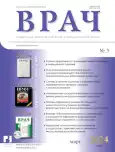The prevalence of non-communicable diseases among working women
- Authors: Amlaev К.R.1, Blinkova L.N.1, Dahkilgova K.Т.1, Mazharov V.N.1
-
Affiliations:
- Stavropol State Medical University, Ministry of Health of Russia
- Issue: Vol 35, No 3 (2024)
- Pages: 25-27
- Section: Health Care Service
- URL: https://journals.eco-vector.com/0236-3054/article/view/629976
- DOI: https://doi.org/10.29296/25877305-2024-03-05
- ID: 629976
Cite item
Abstract
Non-communicable diseases are the main problem of modern society. This review represent data on chronical diseases and their risk factors among working women. It also describes the global trends of main risk factors among working young women and the manifestation of non-infectious diseases, including coronary heart disease, overweight/obesity, arterial hypertension, diabetes mellitus and mental health problems. Long working hours, workload and stress at work were identified as the risk factors of non-communicable diseases. The double burden of work and household duties increased the risk of non-communicable diseases among working women in comparing with working men. State-level strategies were proposed to improve the situation of reducing the prevalence of non-communicable diseases and their prevention. For example, the strategy for the prevention of chronical pathology among working women, included the search of risk factors, strengthening of health policy, the interventions at the working place, including adherence to timetable, the balance between work and personal life.
Full Text
About the authors
К. R. Amlaev
Stavropol State Medical University, Ministry of Health of Russia
Author for correspondence.
Email: kum672002@mail.ru
ORCID iD: 0000-0001-6576-4720
Professor, MD
Russian Federation, StavropolL. N. Blinkova
Stavropol State Medical University, Ministry of Health of Russia
Email: kum672002@mail.ru
ORCID iD: 0000-0003-1429-1278
Сandidate of Medical Sciences
Russian Federation, StavropolKh. Т. Dahkilgova
Stavropol State Medical University, Ministry of Health of Russia
Email: kum672002@mail.ru
ORCID iD: 0000-0002-2726-6381
Сandidate of Medical Sciences
Russian Federation, StavropolV. N. Mazharov
Stavropol State Medical University, Ministry of Health of Russia
Email: kum672002@mail.ru
ORCID iD: 0000-0003-3889-6271
Associate Professor, Сandidate of Medical Sciences
Russian Federation, StavropolReferences
- Budnik L.T., Adam B., Albin M. et al. Diagnosis, monitoring and prevention of exposure-related non-communicable diseases in the living and working environment: DiMoPEx-project is designed to determine the impacts of environmental exposure on human health. J Occup Med Toxicol. 2018; 13: 6. doi: 10.1186/s12995-018-0186-9
- International Labour Office (ILO) (2018) World Employment and Social Outlook – Trends for Women 2018 – Global snapshot. Available at: https://www.ilo.org/global/research/global-reports/weso/trends-for-women2018/WCMS_619577/lang--en/index.htm
- WHO, 2016, WHO NCD and Women. Available at: https://ncdalliance.org/why-ncds/ncds-and-sustainable-development/women-and-ncds
- Sojo V.E., Wood R.E., Genat A.E. Harmful Workplace Experiences and Women’s Occupational Well-Being. Psychol Women Q. 2016; 40: 10–40. doi: 10.1177/0361684315599346
- European Agency for Safety and Health at Work (EU-OSHA) (2014) New risks and trends in the safety and health of women at work. Available at: https://osha.europa.eu/en/publications/reports/new-risks-and-trends-in-the-safety-and-health-of-women-at-work
- Hyun H.S., Kim Y. Associations between working environment and weight control efforts among workers with obesity in Korea. J Int Med Res. 2018; 46 (6): 2307–16. doi: 10.1177/0300060518764212
- Dembe A.E., Yao X. Chronic Disease Risks from Exposure to Long-Hour Work Schedules over a 32-Year Period. J Occup Environ Med. 2016; 58 (9): 861–7. doi: 10.1097/JOM.0000000000000810
- Idris I.B., Azit N.A., Abdul Ghani S.R. et al. A systematic review on noncommunicable diseases among working women. Ind Health. 2021; 59 (3): 146–60. doi: 10.2486/indhealth.2020-0204
- Mawaw P.M., Yav T., Mukuku O. et al. Prevalence of obesity, diabetes mellitus, hypertension and associated risk factors in a mining workforce, Democratic Republic of Congo. Pan Afr Med J. 2017; 28: 282. doi: 10.11604/pamj.2017.28.282.14361
- Al Saweer A., Salehi S., Al Tiho M. et al. Workplace health initiatives. Bahrain Med Bull. 2017; 39: 216–9. doi: 10.12816/0047770
- Mentoor I., Kruger M., Nell T. Metabolic syndrome and body shape predict differences in health parameters in farm working women. BMC Public Health. 2018; 18 (1): 453. doi: 10.1186/s12889-018-5378-9
- Majeed T., Forder P., Mishra G. et al. Women, Work, and Illness: A Longitudinal Analysis of Workforce Participation Patterns for Women Beyond Middle Age. J Womens Health (Larchmt). 2015; 24 (6): 455–65. doi: 10.1089/jwh.2014.5009
- Cerrato J., Cifre E. Gender Inequality in Household Chores and Work-Family Conflict. Front Psychol. 2018; 9: 1330. doi: 10.3389/fpsyg.2018.01330
- Pedersen P.V., Arnfred A., Algren M.H. et al. Comparison of health behaviors among women sex workers to those of the general population of women in Denmark. Women Health. 2016; 56: 376–94. doi: 10.1080/03630242.2015.1101734
- Gibson R., Eriksen R., Singh D. et al. A cross-sectional investigation into the occupational and socio-demographic characteristics of British police force employees reporting a dietary pattern associated with cardiometabolic risk: findings from the Airwave Health Monitoring Study. Eur J Nutr. 2018; 57 (8): 2913–26. doi: 10.1007/s00394-017-1562-4
- Sara J.D., Prasad M., Eleid M.F. et al. Association Between Work-Related Stress and Coronary Heart Disease: A Review of Prospective Studies Through the Job Strain, Effort-Reward Balance, and Organizational Justice Models. J Am Heart Assoc. 2018; 7 (9): e008073. doi: 10.1161/JAHA.117.008073
- Hassan N.E., Wahba S.A., El-Masry S.A. et al. Eating Habits and Lifestyles among a Sample of Obese Working Egyptian Women. Open Access Maced J Med Sci. 2015; 3 (1): 12–7. doi: 10.3889/oamjms.2015.005
- Pinkas J., Bojar I., Gujski M. et al. (2017) Serum Lipid, Vitamin D Levels, and Obesity in Perimenopausal and Postmenopausal Women in Non-Manual Employment. Med Sci Monit. 2017; 23: 5018–26. doi: 10.12659/msm.906895
- Hall B.J., Garabiles M.R., Latkin C.A. Work life, relationship, and policy determinants of health and well-being among Filipino domestic Workers in China: a qualitative study. BMC public health. 2019; 19 (1): 229. doi: 10.1186/s12889-019-6552-4
- Taylor W.C., Suminski R.R., Das B.M. et al. Organizational Culture and Implications for Workplace Interventions to Reduce Sitting Time Among Office-Based Workers: A Systematic Review. Front Public Health. 2018; 6: 263. doi: 10.3389/fpubh.2018.00263
Supplementary files






